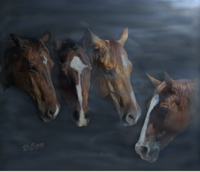
Age / Training
[As additional resources, links to book reviews and book purchasing information can be found beneath the quotations when this information is available.]
Age and Training – Horse
"I like to begin breaking a horse when he is two off and not more than three years old, and to buy if possible in or near September, at which time the animal would be about two and a-half years old. At that age he would have done little or no work, and would consequently be sound.".... Fillis states that he never buys mares and has the stallions castrated and turns them out to grass for 3 ½ months. He goes on to say: "I do not put even a saddle on their backs during these four months, after which I begin their education in the quietest manner possible."
James Fillis, Breaking and Riding
Buy Book
(Top)
"...when those younger horses get pushed so far beyond what they can understand on the start, and where their physical systems aren't developed enough to handle it — why it's just a great waste of something that could have turned out a whole lot different, and a whole lot better. That's the sad part."
Bill Dorrance and Leslie Desmond, True Horsemanship Through Feel
Read Review
Buy Book
(Top)
"So many of those horses get all those lessons crammed in so fast and they have to sort things out in only a few months, when they aren't even three."
Bill Dorrance and Leslie Desmond, True Horsemanship Through Feel
Read Review
Buy Book
(Top)
"There is still another reason that contributes to the formation of these faults: the horses are ridden at too early an age, and because the work demanded of them exceeds their strength and they are not developed enough to resist the degree of control they are subjected to before being trained, their loins are strained, their hocks are weakened, and they are permanently damaged. The proper age for training a horse is six, seven, or eight, according to his native environment."
François Robichon de la Guérinière, The School of Horsemanship, Part II
Read Review
Buy Book
(Top)
"Many young horses who look robust may have deceptively delicate backs which need to be nurtured and gradually developed through careful early training."
Sylvia Loch, The Classical Rider
Read Review
Buy Book
(Top)
"...it takes time and infinite patience to strengthen and encourage the equine back to round and lift. Too many riders push the young horse away from them long before he has learned to come up to meet the seat, and the problems which arise from this lack of awareness have prevented many a sensitive but potentially talented horses from every being able truly to work through or to collect correctly."
Sylvia Loch, The Classical Rider
Read Review
Buy Book
(Top)
"In the western United States and Canada, right into the middle of the twentieth century, it was very common not to do any training at all until the age of four or five, and they were called 'colts' at that age."
Robert M. Miller, D.V.M. and Rick Lamb, The Revolution in Horsemanship
Read Review
Buy Book
(Top)
"Today, as part of the revolution in horsemanship, foal training at a very young age is popular...."
Robert M. Miller, D.V.M. and Rick Lamb, The Revolution in Horsemanship
Read Review
Buy Book
(Top)
"Often, the foundation that is laid at the sale barns for young talent with potential turns these horses into ones that need retraining."
Dr. Gerd Heuschmann, Balancing Act
Read Review
Buy Book
(Top)
"Today, economic interests increasingly drive breeding, training and the hose market. Since time is money, training must be developed as quickly as possible."
Dr. Gerd Heuschmann, Balancing Act
Read Review
Buy Book
(Top)
"Racing and Western horses are ridden at two years old and must be top performers by three. Their sports career is often finished by age five or six."
Dr. Gerd Heuschmann, Balancing Act
Read Review
Buy Book
(Top)
"There is an obvious connection between asking too much of a horse too early and the horse's health."
Dr. Gerd Heuschmann, Balancing Act
Read Review
Buy Book
(Top)
"Less experienced and sales-oriented riders and owners may go astray by training a young sport horse much too intensely; they take the horse to competitions too often, or prematurely start a horse in a difficult test."
Dr. Gerd Heuschmann, Balancing Act
Read Review
Buy Book
(Top)
"Driving young horses to perform at a high level, thus destroying them early, contradicts the concept of horsemanship."
Dr. Gerd Heuschmann, Balancing Act
Read Review
Buy Book
(Top)
"A healthy, well-trained horse may not reach full capacity until he is nine to ten years old."
Dr. Gerd Heuschmann, Balancing Act
Read Review
Buy Book
(Top)
"A young horse needs several months and often even one-and-a-half or two years to be secure in natural balance."
Dr. Gerd Heuschmann, Balancing Act
Read Review
Buy Book
(Top)
"... no colt is ready to be ridden before he is three years old. Those that are grown out early are actually weaker than those that have been allowed to grow at a more normal rate."
Mary Twelveponies, Everyday Training: Backyard Dressage
Read Review
Buy Book
(Top)
"I would not longe any horse before he is two."
Mary Twelveponies, Everyday Training: Backyard Dressage
Read Review
Buy Book
(Top)
"When your horse is at least five years old and far enough along to trot and canter with long, relaxed rhythmic strides yielded to the bit, it is time to start [jumping]."
Mary Twelveponies, Everyday Training: Backyard Dressage
Read Review
Buy Book
(Top)
"I do not think, as some do, training has to be 'complete' by the age of four."
Magali Delgado & Frédéric Pignon, Gallop to Freedom
Read Review
Buy Book
(Top)
Age and Training – Rider
Regarding older students: "...serious determination and increased ability to concentrate — maybe even a little ambition — may outweigh physical shortcomings.
Alois Podhajsky, The Riding Teacher
Buy Book
(Top)
(Top)